Genealogy Research
Genealogy Research consists of the compiling of all basic genealogical
data about ancestors. Its aim is to make the whole ancestry scheme,
and to continue in a detailed search of particular ancestors. Thus,
Genealogy Research precedes Family History Research. As the main
source for Genealogy Research, parish and civil registration records
are usually used.
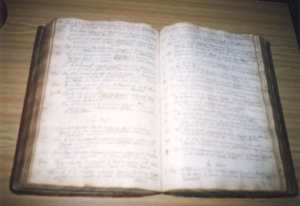
Basic genealogical documents (birth/baptism, marriage and death records)
show basic facts about ancestors and their resident area and provide ground
work for the description of the ancestry history. They are written
in Czech, Slovak, German, Hungarian and Latin.
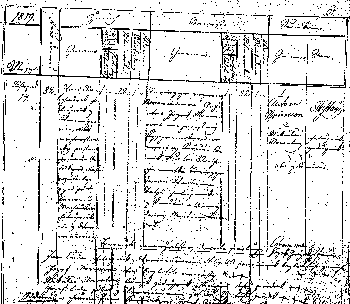
It might be possible to follow Czech or Slovak ancestors relatively reliably
back to 1700, and in some instances even older. It is necessary to
know at least one reference point (at least one place of birth, wedding
or death from your ancestry) to start with the search. Dates do not
need to be precise. The most important facts are the location and the religion.
However, there are more possibilities as to how to proceed to make the
ancestry scheme.
A. Making Pedigree (Ancestry)
Chart
The objective here is to trace all direct ancestors
of one person, through both male and female lines. Direct ancestors´ siblings
are not included. This chart is made backwards, from known person (descendant)
at the present time, to unknown persons (ancestors) in the past. Thus this
schema is ascending. It shows all parental couples and increases geometrically.
If "n" equals a number of generation (n=1 equals a generation of a starting
person, n=2 equals a generation of his/her parents, n=3 of grandparents
etc.), then total number of direct ancestors in "n - th" generation is
" 2n-1 " and a total number of persons mentioned in the Chart
from 1-st to n-th generation is " 2n - 1 ". If some ancestors
who were related marry each other then we find decrease (equality) of ancestors.
The Pedigree (Ancestry) Chart is able to prove a person´s line of descent,
and create a genetic study.
See the diagram of Pedigree (Ancestry) Chart
below:
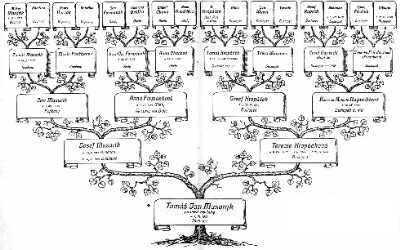
B. Making Descendant Chart on one
direct line
Descendant Chart on one direct line shows direct male-line ancestors only
(father, grandfather, greatgrandfather, etc.) including their families
(wives, brothers and sisters). However, this Chart does not take interest
in descendants of the others. Of course it is possible to concentrate on
female ancestral line. This scheme is made backwards and it is ascending
too. When this process is complete to the past, we have reached the earliest
known ancestor (progenitor). This Chart applies to the description of a
family history, not of an ancestry history, because this Descendant Chart
includes only one ancestry branch of the whole Extended Descendant Chart
on all lines.
See the diagram of Descendant Chart on one
direct line below :
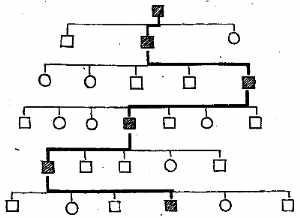
[ ] = male O
= female
[#] = direct male-line ancestor
C. Making Extended Descendant
Chart on all lines
Extended Descendant Chart on all lines is made forwards, from the
earliest known ancestor (progenitor) to all his descendants (with their
spouses) at the present time. The progenitor is a direct ancestor
on male-line (i.e. generally a person keeping the ancestry surname).
This Chart can include either all descendants on male or female line (with
their spouses) or all descendants at all. If it regards to
all descendants on male line, then their main common attribute is their
uniform surname. Thus, this complete scheme shows all the collateral
ancestry branches coming down from one family couple at the top.
It uses a descending consecution. There is a possibility that some
descendants who are related marry each other and we find decrease (equality)
of descendants. Extended Descendant Chart is applicable
to the description of ancestry history and to genetic and demographic
studies.
See the diagram of Extended Descendant Chart on all
lines below:
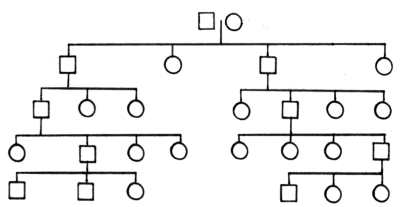
[ ] = male O
= female
D. Making Kin Chart
To make Kin Chart is the most difficult work. It includes Descendant
Charts on all lines of all direct ancestors on both male and
female lines. Thus, the work starts with making an Ancestry Chart
and continues with making Descendant Charts on all lines of all branches
of Ancestry Chart. Kin Chart includes all descendants coming down
from many family couples at the tops of all Descendant Charts
on all lines. It allows to know all people who are related with the starting
person. Kin Chart is applicable to the description of a lot of ancestry
histories and their comparison, to the genetic and demographic studies.
But this type of Chart is not usually used because it is a superhuman
target.
If you are interested in our assistance in researching
the Czech Republic or the Slovak Republic areas, please contact
us.





